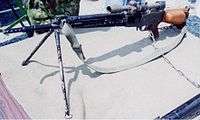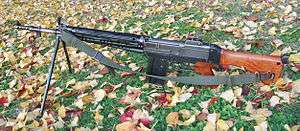Howa Type 64
| Howa Type 64 | |
|---|---|
|
The Type 64 battle rifle | |
| Type | Battle rifle |
| Place of origin | Japan |
| Service history | |
| In service | 1964[1] — present |
| Used by |
Japan Self-Defense Forces Japan Coast Guard Special Assault Team |
| Production history | |
| Designer | General K. Iwashita |
| Manufacturer | Howa |
| Unit cost | ¥188,000 (In 1985)[2] |
| Produced | 1964—1988 |
| Number built | 230,000[3] |
| Variants | See Variants |
| Specifications | |
| Weight | 4.4 kg (9.70 lb)[4] |
| Length | 990 mm (39.0 in)[4] |
| Barrel length | 450 mm (17.7 in)[4] |
|
| |
| Cartridge | 7.62×51mm NATO (modified load) |
| Caliber | 7.62mm |
| Action | Gas-operated[5] tilting bolt |
| Rate of fire | 500 RPM[5] |
| Muzzle velocity | 700 m/s |
| Effective firing range | 400 m |
| Feed system | 20-round detachable box magazine |
| Sights | Iron sights; Telescopic sights used with Designated Marksman variant |
The Howa Type 64 Battle Rifle (64式自動小銃 Roku-yon-shiki-jidou-shoujuu), is a Japanese battle rifle used exclusively by the Japan Self-Defense Forces and the Japanese Coast Guard.[3] It is a gas-operated, selective fire weapon which is chambered for the 7.62×51mm NATO round and uses a detachable 20-round box magazine. The Type 64 was never exported due to Japan's strict anti-hardware export laws. It has been superseded by the more advanced Howa Type 89 from 1989[6] to 1990,[7] but is still in service with all branches of the Self-Defense Forces and the Japanese Coast Guard.
A small number of Howa Type 64 marksman versions had been used by the Special Assault Team.[8]
History
Roughly a decade after the creation of the Japanese Self Defense Forces, the Defense Agency decided to make a domestically designed and manufactured main battle rifle to replace the aging M1 Garand rifles that had been given to them by the United States.[3][9] It was developed by Howa Heavy Industries and eventually was produced in large numbers beginning in 1964 under the direction of General K. Iwashita, who had a hand in designing the rifle.[10][11] When compared to the M14 rifle for testing purposes, it was found to be superior in practical accuracy, likely because its rate of fire and recoil (from less powerful 7.62 NATO ammunition) were lower. However, it has had consistent problems during its service life due to its reportedly overcomplicated construction and is plagued by a false (yet pervasive) reputation for shedding parts during field use and overall unreliability.[10]
Scandal
The J.G.S.D.F's Ōita Prefecture garrison had encountered supply problems when they were not able to account for 30 Howa Type 64s that had been lost, despite a massive search conducted by 95,000 soldiers on January 24, 2007.[12]
Development
Features
- The selector switch on the Type 64 is one of its most famous features due to the manner and order it which it is labeled: ア (アンゼンソウチ/安全装置/Safety device (Safe)) → タ (タンシャ/単射/Semi) → レ (レンシャ/連射/Auto) or “アタレ (Atare); Atare in Japanese means "Hit the target".”
- The weapon's stock was equipped with a hinged buttplate in order to improve accuracy during full-auto fire.
- The Type 64 has an external gas regulator to control cyclic rate.
- The magazine capacity is limited to 20-rounds of 7.62×51mm NATO ammunition. A notable feature of the cartridge used in this weapon is that the powder charge is reduced by about 20%, to reduce its inherently excessive recoil and muzzle climb. It was purposely produced with a reduced powder charge to be more suitable to the Japanese physique.[7][9][13] Because it was designed around this specialized cartridge, the rifle incurs substantially accelerated wear and tear from using full-powered ammunition.[9] Still, the gas regulator has a setting to accommodate normal 7.62×51mm NATO ammunition.[14][15]
Variants
Designated Marksman
Long range optics (scopes) can be installed on the Type 64 rifle so it can be deployed as a sniper rifle.[3] Issuing a Type 64 sniper rifle is usually granted to the individual with the most accurate shooting proficiency in each division (a designated marksman). However, in many cases the individual may simply be issued the scope by itself to be used only during training exercises and shooting competitions, while no specific rifle is assigned to the individual himself.
The issued optics are usually set at 2.2× magnification and may either be a surplus M1C/D sniper rifle M84 scope used by the U.S. Military during World War II or a similar model produced by Nikon that replicates the M84’s magnification levels. Performance is similar to the M1C/D sniper rifle but it is only possible to set the scope to view targets at 500 meters despite the elevation knob being labeled for up to 800 meters. In addition to this, the standard aiming reticule is a simple black “T” which makes it extremely difficult to use during twilight hours or on a black target.
Some serious complaints about the accuracy of the sniper version are linked to the poorly conceived attachment system for the scope. The scope goes askew easily because it is only affixed with one screw. After the scope is mounted and the rifle is zeroed, it is imperative that it be handled carefully because it is easily jostled. Furthermore, since the scope is not usually assigned to any particular rifle it is often difficult to keep it static on any particular rifle’s receiver. This is usually corrected by installing a piece of cloth between the receiver and scope mount, but then the iron sights of the rifle are obscured. In cases like this, it is necessary to install a cheek pad to properly align the users eye with the scope.
The weapon has been phased out in front line units of the Ground Self-Defense Force as it was replaced with the M24 Sniper Weapon System, introduced in 2002 to J.G.S.D.F service.[16]
Current Disposition
The Type 64 is still in use with the Japanese Coast Guard and all three arms of the Japanese Self-Defense Forces, usually with second line units due to budget restrictions on the S.D.F. However, frontline and other units expected to see direct combat are generally issued the Howa Type 89 rifle. The Type 64 essentially uses the same 7.62×51mm NATO ammunition as the M14, M24 Sniper Rifle, Type 62 machine gun, M60 GPMG, and FN MAG so it can easily share ammunition stockpiles of US Military forces stationed in Japan[2] with the reduced powder charge modification. Due to its milled and stamped steel construction and wood furniture, it is considered somewhat anachronistic and heavy by members of the S.D.F.
For a short time, the Special Assault Team had used some Howa Type 64 rifles as sniping weapons.[8]
Gallery
 JGSDF soldiers in olive drab BDUs prepare to fire M31 HEAT rifle grenades during training
JGSDF soldiers in olive drab BDUs prepare to fire M31 HEAT rifle grenades during training- Japan Air Self-Defense Force soldiers from No. 27 Aircraft Control and Warning Group, Ōtakineyama Sub Base, Kawauchi, Fukushima, demonstrate close-quarters combat weapons including Type 64 rifles
- Present Arms fixing bayonet by JGSDF Force
 Captain (CPT) Rod Cromer, supply officer, 1st Brigade, 25th Infantry Division, checks the defensive perimeter of a Japanese soldier during bilateral training in logistics given by the 1st Infantry Division, Japanese Ground Self Defense Force, during Exercise ORIENT SHIELD
Captain (CPT) Rod Cromer, supply officer, 1st Brigade, 25th Infantry Division, checks the defensive perimeter of a Japanese soldier during bilateral training in logistics given by the 1st Infantry Division, Japanese Ground Self Defense Force, during Exercise ORIENT SHIELD Seaman Shusaku Okamura, a Fleet Air Wing 31 air crewman, snaps into the prone position and aims down range during rifle re-qualification and familiarization training at the Indoor Small Arms Range here Dec. 2
Seaman Shusaku Okamura, a Fleet Air Wing 31 air crewman, snaps into the prone position and aims down range during rifle re-qualification and familiarization training at the Indoor Small Arms Range here Dec. 2 The Howa Type 64 DMR variant with a mounted riflescope and modified buttstock to accommodate a cheekrest
The Howa Type 64 DMR variant with a mounted riflescope and modified buttstock to accommodate a cheekrest- Bullets of the Japanese 7.62mm NATO reduced round for Howa Type 64 rifle
See also
| Wikimedia Commons has media related to Type 64 rifle. |
References
- ↑ "Brief History , HOWA MACHINERY". Retrieved 2009-01-18.
- 1 2 "64式7.62mm小銃" (in Japanese). Retrieved 2009-01-18.
- 1 2 3 4 "64式 7.62mm小銃" (in Japanese). Retrieved 2009-11-04.
- 1 2 3 "64式7.62mm小銃" (in Japanese). Retrieved 2009-11-07.
- 1 2 "64式7.62mm小銃" (in Japanese). Retrieved 2009-01-26.
- ↑ "The 5.56 X 45mm: 1986-1994". The Gun Zone. Retrieved 2009-01-27.
- 1 2 "Modern Firearms' Type 64 assault rifle". Retrieved 2009-01-18.
- 1 2 "SAT" (in Japanese). Retrieved 2009-01-25.
- 1 2 3 "HOWA TYPE64 7.62mm RIFLE" (in Japanese). Retrieved 2009-01-18.
- 1 2 "Howa Type 64 Assault Rifle". 2009. Retrieved 2010-07-12.
- ↑ "Howa Type 64 7.62 mm automatic rifle (Japan), Rifles". Jane's Infantry Weapons. Archived from the original on July 13, 2010. Retrieved 2010-07-13.
- ↑ "Japanese Self-Defense Forces: 30 battle rifles unaccounted for…". Retrieved 2009-01-25.
- ↑ 64式小銃 - 銘銃かそれとも・・・ - (in Japanese). Retrieved 2009-01-25.
- ↑ Hogg, 318.
- ↑ "Large calibre assault rifles". Retrieved 2009-01-25.
- ↑ 対人狙撃銃 (in Japanese). Retrieved 2009-11-04.
Bibliography
- Hogg, Ian (2000). Jane's Guns Recognition Guide Second Edition. Glasgow: Janes. ISBN 0-00-472453-4.
